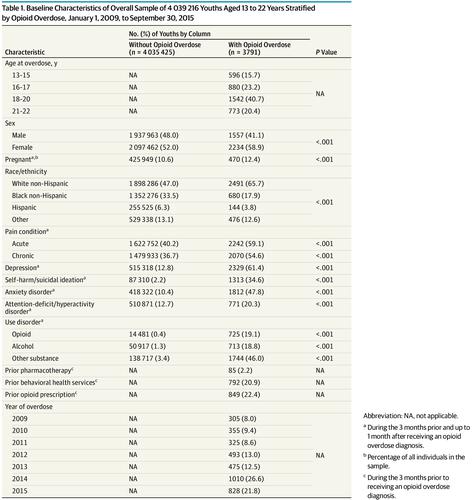当前位置:
X-MOL 学术
›
JAMA Pediatr.
›
论文详情
Our official English website, www.x-mol.net, welcomes your
feedback! (Note: you will need to create a separate account there.)
Receipt of Addiction Treatment After Opioid Overdose Among Medicaid-Enrolled Adolescents and Young Adults
JAMA Pediatrics ( IF 24.7 ) Pub Date : 2020-03-02 , DOI: 10.1001/jamapediatrics.2019.5183 Rachel H Alinsky 1 , Bonnie T Zima 2 , Jonathan Rodean 3 , Pamela A Matson 1 , Marc R Larochelle 4, 5 , Hoover Adger 1 , Sarah M Bagley 4, 5, 6, 7 , Scott E Hadland 4, 6, 7
JAMA Pediatrics ( IF 24.7 ) Pub Date : 2020-03-02 , DOI: 10.1001/jamapediatrics.2019.5183 Rachel H Alinsky 1 , Bonnie T Zima 2 , Jonathan Rodean 3 , Pamela A Matson 1 , Marc R Larochelle 4, 5 , Hoover Adger 1 , Sarah M Bagley 4, 5, 6, 7 , Scott E Hadland 4, 6, 7
Affiliation

|
Importance
Nonfatal opioid overdose may be a critical touch point when youths who have never received a diagnosis of opioid use disorder can be engaged in treatment. However, the extent to which youths (adolescents and young adults) receive timely evidence-based treatment following opioid overdose is unknown. Objective
To identify characteristics of youths who experience nonfatal overdose with heroin or other opioids and to assess the percentage of youths receiving timely evidence-based treatment. Design, Setting, and Participants
This retrospective cohort study used the 2009-2015 Truven-IBM Watson Health MarketScan Medicaid claims database from 16 deidentified states representing all US census regions. Data from 4 039 216 Medicaid-enrolled youths aged 13 to 22 years were included and were analyzed from April 20, 2018, to March 21, 2019. Exposures
Nonfatal incident and recurrent opioid overdoses involving heroin or other opioids. Main Outcomes and Measures
Receipt of timely addiction treatment (defined as a claim for behavioral health services, for buprenorphine, methadone, or naltrexone prescription or administration, or for both behavioral health services and pharmacotherapy within 30 days of incident overdose). Sociodemographic and clinical characteristics associated with receipt of timely treatment as well as with incident and recurrent overdoses were also identified. Results
Among 3791 youths with nonfatal opioid overdose, 2234 (58.9%) were female, and 2491 (65.7%) were non-Hispanic white. The median age was 18 years (interquartile range, 16-20 years). The crude incident opioid overdose rate was 44.1 per 100 000 person-years. Of these 3791 youths, 1001 (26.4%) experienced a heroin overdose; the 2790 (73.6%) remaining youths experienced an overdose involving other opioids. The risk of recurrent overdose among youths with incident heroin involvement was significantly higher than that among youths with other opioid overdose (adjusted hazard ratio, 2.62; 95% CI, 2.14-3.22), and youths with incident heroin overdose experienced recurrent overdose at a crude rate of 20 700 per 100 000 person-years. Of 3606 youths with opioid-related overdose and continuous enrollment for at least 30 days after overdose, 2483 (68.9%) received no addiction treatment within 30 days after incident opioid overdose, whereas only 1056 youths (29.3%) received behavioral health services alone, and 67 youths (1.9%) received pharmacotherapy. Youths with heroin overdose were significantly less likely than youths with other opioid overdose to receive any treatment after their overdose (adjusted odds ratio, 0.64; 95% CI, 0.49-0.83). Conclusions and Relevance
After opioid overdose, less than one-third of youths received timely addiction treatment, and only 1 in 54 youths received recommended evidence-based pharmacotherapy. Interventions are urgently needed to link youths to treatment after overdose, with priority placed on improving access to pharmacotherapy.
中文翻译:

参加医疗补助的青少年和年轻人服用阿片类药物过量后接受成瘾治疗
重要性 当从未被诊断为阿片类药物使用障碍的青少年可以接受治疗时,非致命性阿片类药物过量可能是一个关键接触点。然而,青少年(青少年和年轻人)在阿片类药物过量后接受及时循证治疗的程度尚不清楚。目的 确定非致命性过量服用海洛因或其他阿片类药物的青少年的特征,并评估及时接受循证治疗的青少年的百分比。设计、设置和参与者 这项回顾性队列研究使用了 2009-2015 年 Truven-IBM Watson Health MarketScan 医疗补助索赔数据库,该数据库来自代表美国所有人口普查区域的 16 个未识别身份的州。研究纳入了 2018 年 4 月 20 日至 2019 年 3 月 21 日期间 4 039 216 名参加医疗补助的 13 至 22 岁青少年的数据并进行了分析。 暴露 涉及海洛因或其他阿片类药物的非致命事件和反复服用阿片类药物过量。主要成果和措施 及时接受成瘾治疗(定义为行为健康服务、丁丙诺啡、美沙酮或纳曲酮处方或给药的索赔,或服药过量事件后 30 天内的行为健康服务和药物治疗的索赔)。还确定了与及时治疗以及事件和反复用药过量相关的社会人口学和临床特征。结果 在 3791 名非致命阿片类药物过量青少年中,2234 名(58.9%)为女性,2491 名(65.7%)为非西班牙裔白人。中位年龄为 18 岁(四分位数范围,16-20 岁)。粗事件阿片类药物过量率为每 10 万人年 44.1 例。在这 3791 名青少年中,有 1001 名(26.4%)吸食过海洛因过量; 2790 (73.6%)其余青少年经历过服用其他阿片类药物过量的情况。发生海洛因过量事件的青少年复发性过量用药的风险显着高于发生其他阿片类药物过量的青少年(调整后风险比,2.62;95% CI,2.14-3.22),并且发生海洛因过量事件的青少年在粗略数据中经历了复发性过量用药。比率为每 10 万人年 20 700 人。在 3606 名因阿片类药物过量服用且在过量服用后连续登记至少 30 天的青少年中,2483 名 (68.9%) 在阿片类药物过量事件后 30 天内没有接受成瘾治疗,而只有 1056 名青少年 (29.3%) 仅接受行为健康服务, 67 名青少年(1.9%)接受了药物治疗。海洛因过量服用的青少年比其他阿片类药物过量服用的青少年在过量服用后接受任何治疗的可能性明显较低(调整后的比值比,0.64;95% CI,0.49-0.83)。结论和相关性 在阿片类药物过量服用后,不到三分之一的青少年接受了及时的成瘾治疗,并且只有五分之一的青少年接受了推荐的循证药物治疗。迫切需要采取干预措施,让青少年在服药过量后接受治疗,重点是改善药物治疗的可及性。
更新日期:2020-03-02
中文翻译:

参加医疗补助的青少年和年轻人服用阿片类药物过量后接受成瘾治疗
重要性 当从未被诊断为阿片类药物使用障碍的青少年可以接受治疗时,非致命性阿片类药物过量可能是一个关键接触点。然而,青少年(青少年和年轻人)在阿片类药物过量后接受及时循证治疗的程度尚不清楚。目的 确定非致命性过量服用海洛因或其他阿片类药物的青少年的特征,并评估及时接受循证治疗的青少年的百分比。设计、设置和参与者 这项回顾性队列研究使用了 2009-2015 年 Truven-IBM Watson Health MarketScan 医疗补助索赔数据库,该数据库来自代表美国所有人口普查区域的 16 个未识别身份的州。研究纳入了 2018 年 4 月 20 日至 2019 年 3 月 21 日期间 4 039 216 名参加医疗补助的 13 至 22 岁青少年的数据并进行了分析。 暴露 涉及海洛因或其他阿片类药物的非致命事件和反复服用阿片类药物过量。主要成果和措施 及时接受成瘾治疗(定义为行为健康服务、丁丙诺啡、美沙酮或纳曲酮处方或给药的索赔,或服药过量事件后 30 天内的行为健康服务和药物治疗的索赔)。还确定了与及时治疗以及事件和反复用药过量相关的社会人口学和临床特征。结果 在 3791 名非致命阿片类药物过量青少年中,2234 名(58.9%)为女性,2491 名(65.7%)为非西班牙裔白人。中位年龄为 18 岁(四分位数范围,16-20 岁)。粗事件阿片类药物过量率为每 10 万人年 44.1 例。在这 3791 名青少年中,有 1001 名(26.4%)吸食过海洛因过量; 2790 (73.6%)其余青少年经历过服用其他阿片类药物过量的情况。发生海洛因过量事件的青少年复发性过量用药的风险显着高于发生其他阿片类药物过量的青少年(调整后风险比,2.62;95% CI,2.14-3.22),并且发生海洛因过量事件的青少年在粗略数据中经历了复发性过量用药。比率为每 10 万人年 20 700 人。在 3606 名因阿片类药物过量服用且在过量服用后连续登记至少 30 天的青少年中,2483 名 (68.9%) 在阿片类药物过量事件后 30 天内没有接受成瘾治疗,而只有 1056 名青少年 (29.3%) 仅接受行为健康服务, 67 名青少年(1.9%)接受了药物治疗。海洛因过量服用的青少年比其他阿片类药物过量服用的青少年在过量服用后接受任何治疗的可能性明显较低(调整后的比值比,0.64;95% CI,0.49-0.83)。结论和相关性 在阿片类药物过量服用后,不到三分之一的青少年接受了及时的成瘾治疗,并且只有五分之一的青少年接受了推荐的循证药物治疗。迫切需要采取干预措施,让青少年在服药过量后接受治疗,重点是改善药物治疗的可及性。











































 京公网安备 11010802027423号
京公网安备 11010802027423号